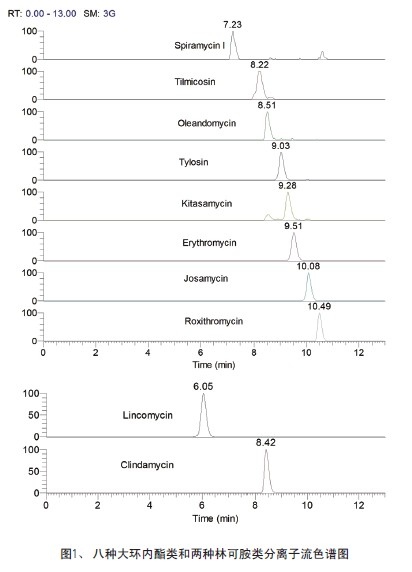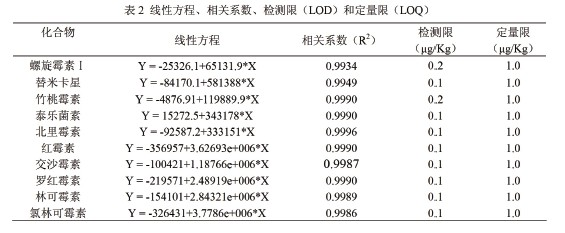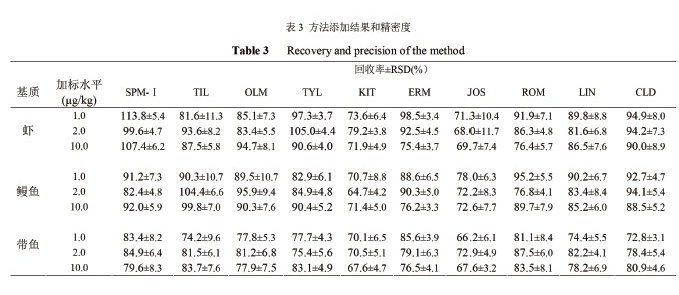液相色谱在线净化-电喷雾串联质谱应用(二)
致。

3.3 线性方程、相关系数、检测限(LOD)和定量限(LOQ)的测定
在选定的条件下,获得了八种大环内酯药物标准曲线的线性方程、相关系数和检测限数据如表2所示。

3.4 回收率的测定
3.4.1 不同添加浓度的回收率通过以上各表可以发现本文用于提取水产品中的大环内酯类抗生素的方法,除替米卡星外,回收率稳定在60~130%之间,精密度小于12%,完全满足日常分析检验的需要。
4.结 论
本文通过在线净化建立了水产品中大环内酯类和林可胺类抗生素的高效液相色谱-电喷雾串联质谱(LC-ESIMS/MS)检测方法。药物残留的检测限( S/N = 3)为0.1-0.2μg/kg,定量限为 1.0 μg/kg。大部分药物在2.0~200 ng/mL时峰强度与质量浓度的线性关系良好(R2> 0.99)。在1.0、2.0、5.0、10.0 μg/kg四个添加水平下,大环内酯类的平均回收率范围为64 %~110 %,相对标准偏差小于11.7 %。结果表明,该法简单、灵敏,通用性好,适用于水产品中大环内酯类残留的分析确证。
参 考 文 献
[1] 李岩,邵兵,徐锁洪.中国卫生检验杂志,
2005,15(10): 1275~1277
[2] 李俊锁,邱月明,王超.兽药残留分析 ,上海科学技
术出版社 2002,413~458
[3] Luo W, Hansen E B, Ang C Y W, Thompson H C,
JAOAC1996, 79, 839
[4] 梁建华,姚国伟.分析化学,2003,31(9):1151
[5] Draisci R, Palleschi L, Ferretti E, Achene L, Cecilia A. J.
Chromatogr. A 2001, 926, 97~104
[6] Masakazu H, Harumi T, Kazuo T. Anal. Chim. Acta, 2003,492
(1~2): 187~197
[7] Thomas S, Thompson D K, Noot J C, Stephen F. Rapid
Commun. Mass Spectrom. 2005,19,309~316
[8] Wang J. J. Agric. Food Chem., 2004,52,171~181
[9] Wang J, Leung D, Lenz S P. J. Agric. Food Chem.,
2006,54,2873~2880
[10] Codony R, Compano R, Granados M, Garcia-Regueiro J,
Dolors P M,J. Chromatogr. A, 959 (2002) 131–141
[11] 徐锦忠,吴宗贤,杨雯荃,杨功俊,陈正行,
丁涛,沈崇钰, 吴斌,蒋原,分析化学
2007,35,166-170.
[12] 徐锦忠,吴斌,丁涛,沈崇钰, 赵增运,陈惠兰,蒋原.
色谱,2006,24(5),436-439.
[13] Thomas S. Thompsona, Donald K. Noot, Jane Calvert,
Stephen F. Pernal, J. Chromatogr. A, 1020 (2003) 241–250
Determination of Macrolide and lincoamide Antibiotic
Residues in aquatic products by LC-ESI-MS/MS with online
cleanup
Jinzhong Xu 1*, Xiaogong Chu 2, Xiaozhong Hu3, Tao Ding 1,
Bin Wu 1, Chongyu Shen 1, Yuan Jiang 1,
(1.Jiangsu Import & Export Inspection and Quarantine Bureau,
Nanjing 210001; 2. Chinese Academy of Inspection and
Quarantine, Beijing 100123; 3. Hubei Import & Export Inspection
and Quarantine Bureau, Wuhan 430022)
Abstract: An analytical method for the determination of
the macrolide and lincoamide antibiotic residues in aquatic
products was developed with on-line cleanup. The procedure
extracted the erythromycin(ERM), roxithromycin (ROM),
tilmicosin (TIL), tylosin(TYL), kitasamycin(KIT), josamycin(JOS),
oleandomycin(OLM), spiramycin I (SPM-I), lincomycin(LIN)
and clindamycin(CLD) from different aquatic product samples.
The macrolide and lincoamide residues were subsequently
separated and cleaned up by the reversed-HPLC and analyzed
by electrospray mass spectrometric detection. The average
recoveries for the macarolides ranged from 64 to 114% in
replicate sets of honey samples fortified with drug concentration
of 1.0, 2.0, and 10.0μg/Kg, and the relative standard deviation
(RSD) were under the 11.7% for intra-day. The method detection
limit and quantitaion limit were 0.1-0.2 μg/kg and 1.0 μg/kg,
respectively.
Keywords: Macrolides antibiotic, aquatic products, residue,
on-line clean up, LC-ESI-MS/MS








